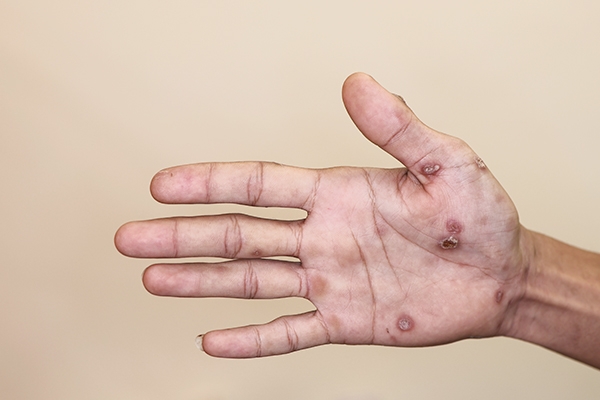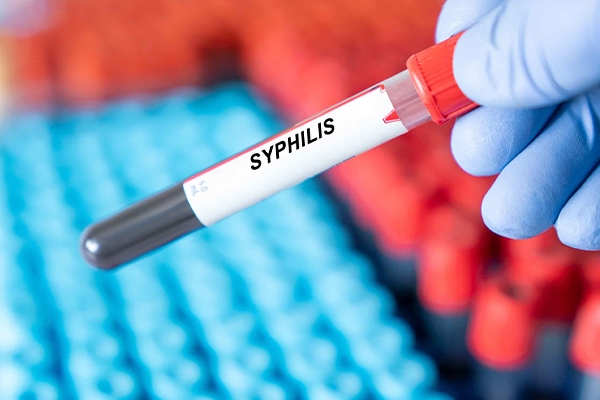Syphilis: Know the Symptoms, Causes, and Treatment Before It's Too Late

Syphilis, also known as the "Raja Singa" disease, is highly contagious. Can this disease be cured?
What is syphilis?
Syphilis is a bacterial infection that is spread through sexual contact. This sexually transmitted disease is caused by the bacteria Treponema pallidum, which enters the body through broken skin or mucous membranes, usually in the genital area.
How is syphilis transmitted?
Syphilis is transmitted through unprotected vaginal, anal, or oral sex with someone who is in the early stages. In addition, syphilis can also be spread through kissing or direct contact with sores on the lips, mouth, tongue, or genitals.
In pregnant women, this infection can be transmitted to the baby during pregnancy or childbirth.
Syphilis cannot be spread through everyday contact with objects that sufferers have touched. You will not get syphilis just by using the same toilet, bathtub, clothing, eating utensils, doorknobs, swimming pool, or tub as an infected person.
Four stages and symptoms of syphilis

There are 4 stages of syphilis: primary, secondary, latent, and tertiary.
1. Primary syphilis
The incubation period for primary syphilis is 14 to 21 days. Syphilis is highly contagious at this time and sometimes goes unnoticed because it has no symptoms.
Symptoms usually begin with sores (ulcers) in the genital area (vagina or penis), anus, or mouth. The sores:
- are overlooked because they are hidden or painless;
- one or more sores appear in areas of sexual contact, such as the mouth, rectum, vagina, or cervix;
- are often painless;
- appear 3-4 weeks after infection;
- heal on their own within 4 weeks.
The bacteria that cause syphilis can continue to live in the body, but there are few symptoms until the second stage.
2. Secondary syphilis
Symptoms of secondary syphilis begin to appear 2 to 8 weeks after primary syphilis and are highly contagious.
Symptoms include
- A skin rash, usually on the palms of the hands and soles of the feet or the body’s surface.
- Sores are called mucous patches in or around the mouth, vagina, or penis.
- Moist, warty patches (condyloma lata) on the genitals or skin folds.
- Fever.
- Loss of appetite.
- Muscle and joint pain.
- Swollen lymph nodes.
- Vision changes.
- Hair loss, especially the eyebrows.
Primary and secondary syphilis usually resolves without treatment. At that point, syphilis becomes latent and may not cause symptoms for years. However, during this time, syphilis can damage organs, leading to tertiary syphilis.
3. Latent syphilis
During this stage, the syphilis bacteria are still alive in your body, but you have no signs or symptoms of infection. During this stage, you are not contagious, but the syphilis infection may still affect your heart, brain, nerves, bones, and other parts of your body. This stage can last for years.
For many people, symptoms do not progress beyond the latent stage, either because the infection clears up on its own or because the symptoms are too mild to notice. Some people will enter the tertiary stage.
4. Tertiary syphilis
Tertiary syphilis develops in people who are infected but not treated. The infection can appear months to years after the initial infection.
At this stage, syphilis is not contagious and can still be treated.
Symptoms vary widely and are difficult to diagnose, including:
- heart damage, causing aneurysms or valve disease;
- central nervous system disorders (neurosyphilis);
- tumors of the skin, bones, or liver.
Screening and testing

There are three types of testing for syphilis: the non-treponemal test (VDRL), the treponemal test (TPHA), and the rapid syphilis test (Rapid Test Syphilis).
1. Non-Treponemal Test (VDRL)
VDRL (Venereal Disease Research Laboratory) is a test method to detect whether someone is likely to be infected with syphilis. This test does not directly detect the Treponema pallidum bacteria but rather measures the levels of antibodies (IgG and IgM) produced by the body due to cell damage caused by the bacterial infection.
However, these antibodies can also appear due to other acute infections, such as viral infections, or in chronic diseases, such as autoimmune diseases.
Because VDRL has high sensitivity but is not specific, a positive result does not always indicate that someone has syphilis. Therefore, additional examinations or retesting are needed to confirm the diagnosis. VDRL is commonly used as an initial test (screening) and to monitor the effectiveness of syphilis treatment.
2. Treponemal Test (TPHA)
TPHA (Treponema pallidum Hemagglutination Assay) is a serological test that detects the presence of specific antibodies to the Treponema pallidum bacteria.
Unlike VDRL, TPHA is more specific, so it is more accurate in confirming whether someone has had or is currently experiencing a syphilis infection.
TPHA is typically used alongside non-treponemal tests to determine whether an infection is active or if the detected antibodies are remnants of a past, treated infection. This test may remain positive or reactive for life, even after successful syphilis treatment.
This test cannot distinguish between an active infection and one that has been successfully treated. Additionally, it does not differentiate T. pallidum infections from other treponemal infections. To aid in the diagnosis, a thorough history of sexual behavior, exposure, and travel to endemic areas is essential.
3. Rapid Syphilis Test
TP Rapid can only be used as a substitute for the TPHA examination in a series of non-treponemal tests. This rapid test is user-friendly and provides results in a relatively short time (10 - 15 minutes). Compared to TPHA, its sensitivity ranges from 85% to 98%, and its specificity ranges from 93% to 98%.
The currently available rapid syphilis test, TP Rapid, is in the treponemal-specific category. It detects specific antibodies against various treponemal species (not always T. pallidum). Therefore, this test cannot differentiate active infection from well-treated infection. TP Rapid only detects Treponema infections.
Syphilis treatment

If the VDRL and TPHA test results are positive, there is a potential for active syphilis infection, and immediate treatment is needed. The main treatment for syphilis is antibiotics from the penicillin group.
If the infection has occurred for less than a year, one injection is enough to stop the disease. However, if the infection has been going on for a long time, therapy can take 14 days or more.
In advanced syphilis (secondary or tertiary), the duration of treatment can be longer. If the patient is allergic to penicillin, the doctor can prescribe other alternative antibiotics. Therefore, it is highly recommended to consult a dermatologist-venereologist for the right diagnosis and appropriate therapy.
After treatment, antibodies detected through VDRL can persist in the body for 6 to 24 months before finally disappearing. Meanwhile, TPHA will usually remain positive for life, indicating that someone has had a syphilis infection even though they have fully recovered.
**
Syphilis can be cured. Even though you have recovered, it does not mean you cannot be reinfected. You can be reinfected if you come into contact with an infected person.
If you need to consult further about this disease, visit the GWS Medika Clinic, a health clinic in Jakarta. You can also get information related to sexual health screening by clicking WhatsApp.



